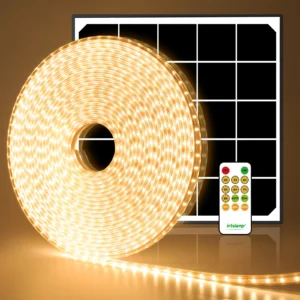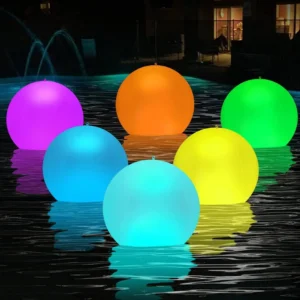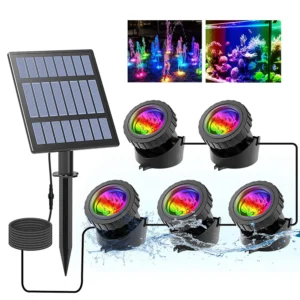Solar lights are an eco-friendly and cost-effective outdoor lighting solution, but using them in winter presents unique challenges. With shorter days and less sunlight, maintaining their efficiency becomes crucial. This guide will provide you with essential tips on how to charge solar lights in winter and ensure they remain functional throughout the season.
Can Solar Lights Be Used in Winter?
Yes, solar lights can be used in winter, but their effectiveness may vary based on several factors. Understanding how solar lights operate and the necessary modifications for winter use can help ensure they remain functional even during the colder months.
Explanation of Solar Lights’ Operation
Solar lights function by harnessing sunlight through solar panels, which are made up of photovoltaic cells. These cells convert sunlight into electricity, which is then stored in rechargeable batteries. When the sun sets, a light-sensitive control switch activates the lights, allowing them to illuminate outdoor spaces without the need for wiring or external power sources.
The efficiency of solar lights largely depends on the amount of sunlight they receive. During summer, long days and abundant sunlight typically provide ample energy for these lights to operate effectively throughout the night. However, as winter approaches, shorter days and limited sunlight can pose challenges for solar lights, impacting their ability to charge and maintain brightness.
Discussion of Modifications Needed for Winter Use
To maximize the performance of solar lights during winter, consider the following modifications:
Optimal Placement: Position solar lights in areas that receive maximum sunlight throughout the day. Avoid shaded locations created by trees, buildings, or other obstructions. A south-facing orientation is often the best choice, allowing the panels to capture sunlight for as long as possible.
Regular Maintenance: Cleaning solar panels is crucial, especially in winter when dirt, snow, or ice can accumulate and block sunlight. Regularly wipe the panels to ensure they can absorb as much solar energy as possible.
Battery Considerations: Cold temperatures can reduce the efficiency of batteries. Before winter, consider upgrading to heat-resistant batteries that can withstand lower temperatures without losing their charge quickly. Additionally, replacing old batteries with new ones can significantly improve performance.
Supplementary Heating: In extremely cold conditions, consider using a solar panel heater to help maintain optimal battery temperature. Keeping the batteries warm can help prevent energy loss and ensure the lights function reliably.
Use of External Battery Packs: For added energy storage, external battery packs can be utilized. These packs can store extra energy generated during sunny days, providing a backup power source during the longer, darker winter nights.
How to Charge Solar Lights in Winter
To ensure your solar lights remain efficient and functional during winter, follow these essential tips for optimal charging and performance.
Tip 1: Position Solar Lights for Maximum Sunlight
The placement of your solar lights is critical to their performance. During winter, sunlight is less intense and days are shorter, so it’s vital to position your solar lights in areas that receive direct sunlight for the majority of the day. South-facing locations are ideal, as they receive the most sunlight. Avoid placing lights in shaded areas created by trees, buildings, or fences, as these obstructions can significantly reduce the amount of sunlight the solar panels absorb, impacting their ability to charge effectively.
Tip 2: Clean Solar Panels Regularly to Ensure Efficiency
Dirt, dust, snow, and debris can accumulate on solar panels, obstructing sunlight and hindering their efficiency. Regularly cleaning the solar panels will ensure they can absorb as much sunlight as possible. Use a soft cloth or sponge with mild soap and water to gently wipe the panels clean. In winter, be particularly vigilant about removing snow or ice that may cover the panels, as even a small amount can dramatically decrease their ability to charge.
Tip 3: Use a Solar Panel Heater to Keep Batteries Warm
Cold temperatures can reduce the efficiency of solar cells and batteries, leading to quicker energy depletion. To combat this, consider using a solar panel heater. This device can help keep the solar panels and batteries warm, preventing energy loss due to cold. Position the heater in a way that allows it to warm the solar panel without obstructing sunlight. By maintaining a stable temperature, your solar lights can charge more effectively and retain energy for longer periods.
Tip 4: Swap Out Old Batteries for New Ones
The performance of solar lights can be significantly affected by the condition of their batteries. If the batteries are old or have been used for several seasons, they may not hold a charge as well as new ones. Before winter sets in, replace old batteries with fresh, high-capacity rechargeable batteries. This simple step can enhance the efficiency of your solar lights, ensuring they can store enough energy to illuminate your space during the longer winter nights.
Tip 5: Consider Heat-Resistant Batteries
Standard rechargeable batteries may struggle in cold temperatures, leading to diminished performance. Investing in heat-resistant batteries can help address this issue. These batteries are designed to operate efficiently in lower temperatures, retaining energy better and preventing quick drainage. By using heat-resistant batteries, you can help ensure your solar lights maintain functionality even in harsh winter conditions.
Tip 6: Use an External Battery Pack for Extra Energy
An external battery pack can provide additional energy storage for your solar lights. This is especially useful in winter, as it allows you to store extra energy generated during sunny days and use it to keep your lights lit during the night. External battery packs can be connected to your solar lights, enhancing their performance and ensuring they have a reliable power source, even when sunlight is limited.
Tip 7: Opt for LED Solar Lights to Reduce Energy Consumption
LED solar lights are more energy-efficient compared to traditional incandescent options. They require less energy to operate, which means they can store energy more easily and stay illuminated for longer periods. By choosing LED solar lights, you enhance energy efficiency, making them more resilient against the challenges of winter. This choice not only improves performance but also contributes to lower energy consumption, making them a sustainable lighting solution year-round.
By following these tips on how to charge solar lights in winter, you can maximize their efficiency and ensure reliable illumination throughout the colder months. With careful placement, regular maintenance, and the right equipment, your solar lights can thrive even in less-than-ideal conditions.
How to Store Solar Lights Over Winter
Properly storing your solar lights during the winter months is essential for maintaining their functionality and extending their lifespan. Follow these steps to ensure they remain in excellent condition until spring.
Step 1: Wash the Lights Before Storage
Before storing your solar lights, it’s important to give them a thorough cleaning. Over time, dirt, debris, and even dust can accumulate on the solar panels and the fixtures themselves, impacting performance. Use a soft cloth or sponge with a mild detergent or just plain water to gently wash the surfaces. Make sure to clean both the solar panels and the decorative parts of the lights to remove any grime that could hinder their performance when reinstalled.
Step 2: Dry Thoroughly to Prevent Corrosion
After washing, ensure that your solar lights are completely dry before storing them. Moisture left on the lights can lead to corrosion and damage, particularly to the electrical components and batteries. Use a soft towel to wipe down the lights and allow them to air dry in a warm area. Ensure that the solar panels are dry, as any remaining water can lead to frost damage or mildew growth during the winter months.
Step 3: Remove Batteries to Avoid Damage
Removing the batteries from your solar lights is a critical step in the storage process. Leaving batteries in the lights can lead to corrosion, leakage, or damage over the winter, especially if temperatures drop significantly. Store the batteries separately in a cool, dry place, and consider checking their charge level before storage. If they are old or depleted, replace them to ensure your solar lights are ready to go when you bring them out in spring.
Step 4: Fully Charge Before Storing
It’s a good idea to fully charge your solar lights before putting them away for the winter. This ensures that the batteries are at their optimal capacity when you store them. Place the lights in direct sunlight for a full day to allow the batteries to charge completely. This step not only keeps the batteries healthy but also ensures that your solar lights are ready for immediate use once spring arrives.
Step 5: Store in a Cool, Dry Place
Choosing the right storage location is vital for protecting your solar lights. Store them in a cool, dry area that is free from extreme temperatures and humidity. Avoid places like basements or garages where moisture can accumulate. A closet, shed, or storage box that is well-ventilated can work well. Proper storage conditions help prevent damage from cold or damp conditions, ensuring your lights remain in good working order.
Step 6: Label for Easy Retrieval in Spring
To streamline the process of retrieving your solar lights in the spring, consider labeling the storage containers or bags. Include details such as the type of lights and their previous locations. This will help you quickly identify which lights to set up and where to place them, saving you time and effort when you’re ready to re-install them.
Step 7: Check Periodically to Ensure They’re in Good Condition
Even while in storage, it’s a good practice to check on your solar lights periodically throughout the winter. Inspect the lights for any signs of damage, corrosion, or moisture buildup. Ensure that the batteries are in good condition and not leaking. Regular checks can help you address any issues early, ensuring your solar lights are ready to shine as soon as you bring them back out in the spring.
Conclusion
By following these tips on how to charge solar lights in winter and proper storage techniques, you can maximize their efficiency and enjoy the benefits of solar lighting year-round. Whether you choose to keep them in use or store them for the season, these strategies will help maintain their functionality through the colder months.


















